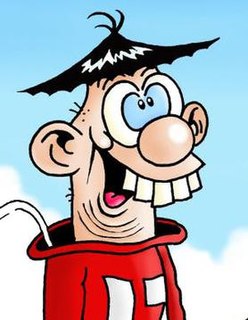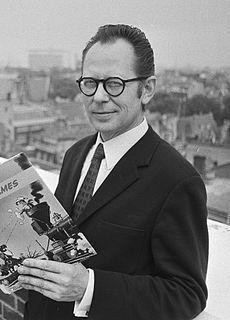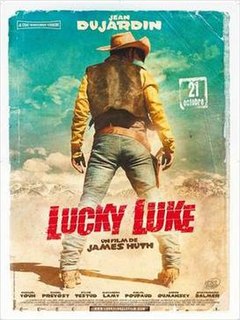
Calamity James is a comic strip in the UK comic The Beano. It is about a boy, named Calamity James, who has disastrous luck. He first appeared on 1 November 1986, in issue no. 2311. A copy of his first strip is viewable here. His strip replaced Biffo the Bear and Little Plum, which had both been reduced to a half-page by this time. He has a pet called Alexander Lemming,.

The Family Circus is a syndicated comic strip created by cartoonist Bil Keane and, since Bil's death in 2011, is currently written, inked, and colored by his son, Jeff Keane. The strip generally uses a single captioned panel with a round border, hence the original name of the series, which was changed following objections from the magazine Family Circle. The series debuted on February 29, 1960, and has been in continuous production ever since. According to publisher King Features Syndicate, it is the most widely syndicated cartoon panel in the world, appearing in 1,500 newspapers. Compilations of Family Circus comic strips have sold over 13 million copies worldwide.

Lucky Luke is a Western bande dessinée series created by Belgian cartoonist Morris in 1946. Morris wrote and drew the series single-handedly until 1955, after which he started collaborating with French writer René Goscinny. Their partnership lasted until Goscinny's death in 1977. Afterwards, Morris used several other writers until his own death in 2001. Since Morris's death, French artist Achdé has drawn the series, scripted by several successive writers.
Harri Sakari Vaalio, also known by his artist name Wallu, is a Finnish cartoonist. He is known for his strip "Punaniska" comic albums and his strips in Finnish magazines such as the "Mikrokivikausi" strip in the computer magazine MikroBitti. He has also written and drawn 12 Winnie the Pooh stories for the Finnish Winnie the Pooh magazine in 1986-1988. His other comics includes Hessu-kissa, Armas, also known as Lämsänperäläiset, and KyöPelit. In the early 1980s he was a teacher in the local elementary school, now known as Vuokkoharjun ala-aste.

The Daltons are fictional outlaws in the Lucky Luke Western comics series and the most recurring arch-enemies to Lucky Luke. They were created by artist Morris and writer René Goscinny. They are loosely inspired by the historic Dalton Gang of the United States, active in the early 1890s, and are billed as their cousins. While Morris depicts the historic Dalton brothers as evil and successful, these Daltons are portrayed as less skillful and more prone to fighting among the siblings. The four Daltons are depicted as identical except for height and intelligence. The oldest brother Joe is shown as the shortest and smartest, and the youngest brother Averell as the tallest and dumbest.
Mikrokivikausi is a Finnish comic strip drawn by Harri "Wallu" Vaalio.

Jolly Jumper is a horse character in the Franco-Belgian comics series Lucky Luke, created by Belgian artist Morris. Described as "the smartest horse in the world" and able to perform tasks such as chess-playing and tightrope walking, Jolly Jumper accompanies his cowboy in their travels across the Wild West, and delivers frequent quips. In the Greek version of the series, Jolly Jumper is female and is called "Dolly". In the Turkish Version the character is called "Düldül".
Tom Paterson is a Scottish comic artist who drew characters for Fleetway in 1973–1990, and D.C Thomson from 1986-2012. As of 2013, he currently draws strips for Viz. He lives in Leith, with three children, and is a Hearts supporter.

Calamity Jane is a Lucky Luke comic written by Goscinny and illustrated by Morris. It was originally published in French by Dupuis in 1967. English editions of this French series have been published by Dargaud, and Cinebook in 2007.

Lucky Luke contre Joss Jamon is a Lucky Luke comic written by Goscinny and Morris. It is the eleventh album in the Lucky Luke Series and the second on which Goscinny worked. The comic was printed by Dupuis in 1958 and in English by Cinebook in 2011, under the title Lucky Luke versus Joss Jamon.

La Ballade des Dalton is a 1978 French animated film written and directed by René Goscinny, Morris, Henri Gruel and Pierre Watrin starring the comic book character Lucky Luke. Two different adaptations of the film in book form were both published in French in 1978. The first, adapted by Guy Vidal, was in text form rather than comic strip, and was accompanied by images from the film. The second was a comic strip adaptation by an uncredited Pascal Dabère and formed part of the book, La Ballade des Dalton et autres histoires.

Fingerpori is a Finnish comic strip written and drawn by Pertti Jarla. It started in Helsingin Sanomat in February 2007, and is comprehensively distributed in major provincial newspapers. Literally, fingerpori is a thimble, but fingerporillinen is a proverbial small amount of alcohol, and Pori is a Finnish town.

Martha Jane Cannary, better known as Calamity Jane, was a well-known American frontierswoman, sharpshooter, and raconteur. In addition to many exploits she was known for being an acquaintance of Wild Bill Hickok. Late in her life, she appeared in Buffalo Bill's Wild West show and at the 1901 Pan-American Exposition. She is said to have exhibited compassion to others, especially to the sick and needy. This facet of her character contrasted with her daredevil ways and helped to make her a noted frontier figure. She was also known for her habit of wearing men's attire.

Western comics is a comics genre usually depicting the American Old West frontier and typically set during the late nineteenth century. The term is generally associated with an American comic books genre published from the late 1940s through the 1950s. Western comics of the period typically featured dramatic scripts about cowboys, gunfighters, lawmen, bounty hunters, outlaws, and Native Americans. Accompanying artwork depicted a rural America populated with such iconic images as guns, cowboy hats, vests, horses, saloons, ranches, and deserts, contemporaneous with the setting.

Maurice De Bevere, better known as Morris, was a Belgian cartoonist, comics artist, illustrator and the creator of Lucky Luke, a bestselling comic series about a gunslinger in the American Wild West. He was inspired by the adventures of the historic Dalton Gang and other outlaws. It was a bestselling series for more than 50 years that was translated into 23 languages and published internationally. He collaborated for two decades with French writer René Goscinny on the series. Morris's pen name is an Anglicized version of his first name.

Les Nouvelles Aventures de Lucky Luke is a 2001-2003 animated television series based on the Franco-Belgian comic book series of the same name created by Belgian cartoonist Morris. 52 episodes were produced.

Lucky Luke is a 2009 French-Argentine Western adventure film directed by James Huth and starring Jean Dujardin, who also co-wrote the screenplay. It is based on the comic series of the same name by Morris. The film includes a cameo by Argentine writer and TV host Alberto Laiseca.
Lucky Luke is an animated television series based on the comic book series of the same name created by Morris. The series lasted for 26 episodes, and co-produced by Hanna-Barbera, Gaumont, Extrafilm and FR3. In France, the series was broadcast from 15 October 1984 on FR3. In the United States, the show aired in syndication on various CBS and ABC stations.
School Friend was the name of two different weekly publications marketed toward girls, both of which were pioneering in their respective categories. The first School Friend, published from 1919 to 1929, was the first story paper marketed exclusively to girls. The second School Friend, published from 1950 to 1965, is considered the first British girls' comic. Although both published by Amalgamated Press, and both marketed toward girls, the content of the two publications was not directly related.